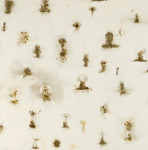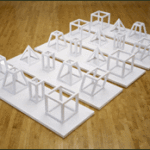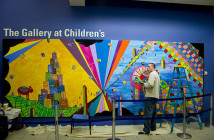The ubiquity of the grid in our culture may explain the fascination with it. Unconsciously, consciously and self-consciously, artists, designers, mathematicians and just about everybody who’s ever sat in front of a computer employs the grid to make sense of their work. The grid seems to be the best way to organize information, aesthetic or other, on a two-dimensional plain. After Abstract Expressionism, the grid became a popular structure for painting, and shortly thereafter, Andy Warhol seemed to use the grid just to show how much we take ‘the grid’ for granted.
Quantum Grids, at Harvard’s Sert Gallery, displays the labors of Linda Norden, associate curator of contemporary art, in showing off two loans from art dealer Stephen Mazoh, Sol LeWitt’s Four-Part Geometric Structure (1978-79) and Yayoi Kusama’s Accretions, II (1967) along with one of Harvard’s earliest modern art acquisitions, Cai Guo-Qiang’s The Century with Mushroom Clouds (1996) and an exceptionally recent purchase, Guilty (2005) by Fred Tomaselli. Grids attempts to associate the geometric quality of LeWitt’s work with the others in the show in order to emphasize their own fundamentals of organization. The idea of “Quantum” is an analogy to LeWitt’s philosophy and the evolution of its appreciation in the art world to the evolution of the acceptance of Quantum Mechanics as the foundation for the physical sciences (I’ll let you figure this one out). In the show’s brochure, Norden states that, “’quantum’ is often inseparable from ‘leap’” bringing to mind images of Scott Bakula leaping through time and space, bringing his Gulf War I era virtues to history. In fact, whenever I hear the word ‘quantum’ followed by anything but mechanics or perhaps physics, I think of science fiction, but Norden keeps it open, wanting us only to consider “the ungraspable range that ‘leap’ would describe.”
Sol LeWitt is the patriarch of the show. He is the oldest, though by only a year, of the four artists in the show and a father of conceptualism and minimalism. His work is the most prominent in the show as it sits centered on the floor of the gallery, and Norden buoys her essay with his theory and art-historical importance. His work is made up of five white floor panels, each one with four of the five white 3-D geometric models situated in a line down the panel. It seems as though he took five sets of four of the same objects, and arranged them in the most random way possible. It is the maximum level of disorder allowed with the gridded constraints he set out for himself; it is experimenting with subjectivity within an ostensibly objective space.
Kusama’s near infinite number of shapes, each one painted in white on a three paneled, dark red paint background, move beyond the boundaries of LeWitt’s stuffy grid. Each shape, around one square centimeter in size, is unlike every other one. It would be foolish to denote such a random field of images a ‘grid,’ but next to LeWitt, the organic nature of her work becomes much more palpable.
The grid in Tomaselli’s work, Guilty, is actually the perforations of the LSD tab sheet where he has printed an image. He does not self-consciously reference ‘the grid’ like LeWitt, but like his other work, references his drug filled past. Unlike his other works, however, which look like cosmos of popular images and pills, this one uses his typical drug-theme in a slightly more subtle fashion. The LSD (coincidentally, the inventor of LSD, Albert Hofmann, turns 100 this week.) tabs are not nearly as familiar as the Prozac pills which frequently appear in his large paintings and printed on the paper is the 16 March New York Times, pictured on the cover is the just arrested Bernard Ebbers, whose image Tomaselli has painted with a few psychedelic flourishes.
Cai Guo-Qiang’s three-part The Century with Mushroom Clouds includes a video of military footage including enough mushroom clouds to put the ending montage of Dr. Strangelove to shame, postcards of images from the video, and a wall-covering painting of mushroom clouds executed with gunpowder. The mushroom clouds look as though they were made by a stencil, which was filled with gunpowder, which itself was then lit. He did this enough times to cover the entire tarp-sized paper in a several weeklong performance. The work references his own history as well as the history of the 20th century. He was raised in the Quanzhou province of China, where the main industry is gunpowder, lending much to his body of work which later included full-scale explosions. Cai’s use of the mushroom cloud gives a history of the 20th century in a repeated image of one of its most unforgettable icons, in the same way that Warhol might repeat an image of Marilyn Monroe. Cai’s work also has little to do with ‘the grid’ but like Kusama, the juxtaposition of his work with LeWitt’s provides the foundation for the dialogue this show wishes to incite.
While revealing the possible subjectivity of LeWitt, the exhibition sets up the other artists to be understood as ‘grid,’ a concept essential as 1+1=2, however, I’m in the same place I was before I entered the show. Why impose the “grid-idea” on such great works of art? We don’t need it to understand nor, moreover, appreciate them. Though the association of LeWitt with the other artists indeed brings about another way to appreciate them, the show’s focus seems pedantic. Norden is not shy about the opportunistic grounds for this show—she reveals that the prospect of exhibiting the loans of LeWitt and Kusama along with the chance to show Cai’s work, heretofore existing only in storage yet being one of Harvard’s first modern art acquisitions, is the primary reason for organizing the exhibition. The Tomaselli work, which was oddly added to the show’s roster after the press release went out (see the show’s listing in the Boston Phoenix a week before the show opened), was purchased in honor of Norden. Though the comparative size of the work and its placement in the show lessens its significance, it still calls into question the show’s legitimacy. The opportunity to view these works is wonderful, but I fear the opportunity to display them may have been a little more satisfying.
Links:
Harvard University Art Museums
"Quantum Grids: Cai Guo-Qiang, Yayoi Kusama, Sol LeWitt, and Fred Tomaselli" is on view from October 15, 2005 through April 16, 2006 at the Sert Gallery, Carpenter Center for the Visual Arts.
All images are courtesy of the artists and Harvard University Art Museums.




